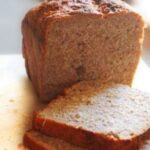Many long years ago, I was given a loaf of Swedish Limpa Rye Bread, by a neighbor I was friendly with at that time. I had been making bread for over 10 years at the time and knew the basics. I had never come in contact with anyone Swedish before, and I seem to be attracted to different cultures and their foods. I took the loaf home with me and ate a slice. Oh my, was it good. I had to know the recipe.
I went back to her house next day to inquire about the recipe. She explained to me that each year when her grandmother came from Sweden to visit, she would make this bread. The recipe was huge, she warned me, and somehow it just never tasted right if not made from the full recipe, which made about 10 or 12 loaves, depending on size. She gave me the recipe to copy, and I took it home, determined. I did cut the recipe in half, despite her warnings, and the bread was very good, though her original loaf, in my memory, seemed to have been better. I couldn’t specifically say what was different. Still, it was really good bread, and far different from any I had tasted before, so I was thrilled to have the recipe.
That was almost 30 years ago now, and it has been many years since I made this bread. Thinking about putting the recipe on my website, I was curious. Why is it called Limpa? What is Limpa? I still have no firm answer. What it appears is that it is the descriptor for this type of rye bread, though I could easily be in error. In researching, I have seen that while the recipe I have had all these years is made with most of the basic ingredients, in almost every recipe found there is either anise, fennel or orange rind added. In some cases there are other things added such as oatmeal and even mashed potato. The basic ingredients seem to be molasses, rye flour and white flour. Some kind of fat is used. My recipe calls for shortening, though I have read that lard is actually a more traditional ingredient. Sometimes butter is used, and sometimes it is used half and half with shortening. Many recipes have changed the traditional molasses to dark corn syrup.
Then I also found that this bread was traditionally called Vort Bread, as it was made using wort, or vort in Swedish, which is a product created in the beer brewing process. An acceptable substitute these days for the wort is a stout beer. Even so, very few of the recipes I found actually called for the use of a stout beer, but usually just use water or orange juice as the liquid in the recipe.
In all, looking at the recipe my friend gave me, it is very basic, but it was still fabulous bread. The possible additions of the spices, fennel, orange rind, anise, and in one case star anise would certainly make this bread festive. I read that it is often made as holiday bread for Christmas or Yule. My friend said her grandmother made the bread often, so obviously it was not considered solely holiday bread in her family.
I find it a fascinating study to read all the different posts of recipes and note all the diversity in one specific type of bread. Many of the differences are most likely regional. I have seen much of this in recipes handed down in my Slovak family. In a small country such as Guatemala, tamales differed from town to town, so surely this bread differs from area to area or family to family. I still savor the memory of the bread with the recipe I have and intend making it again soon. I hope many of you will search out the recipe and try it, too.
Thank you for taking the time to read my article. I hope it was informative and helped you along your own culinary journey




